Samsung Electronics Co GTB7810 Cellular/PCS GSM Phone with WLAN and Bluetooth User Manual
Samsung Electronics Co Ltd Cellular/PCS GSM Phone with WLAN and Bluetooth Users Manual
Contents
- 1. Users Manual
- 2. User Manual
Users Manual
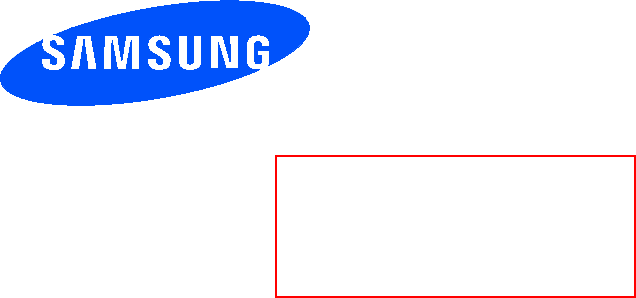
User manual
GT-B7810
Draft 6
2012-05-03
Only for Marketing

using this manual
This user manual has been specially designed to guide you through the functions
and features of your mobile phone. To get started quickly, refer to “introducing your
mobile phone,
Instructional icons
Before you start, familiarise yourself with the icons you will see in this manual:
Warning—situations that could cause injury to yourself or others
Caution—situations that could cause damage to your phone or other
equipment
Note—notes, usage tips, or additional information
Refer to—pages with related information; for example: p. 12
(represents “see page 12”)
Õ Followed by—the order of options or menus you must select to perform a
step; for example: In Menu mode, select Messages Õ Create new message
(represents Messages, followed by Create new message)
[ ] Square brackets—phone keys; for example: [ ](represents the Power/
Menu exit key)
< > Angled brackets—softkeys that control different functions at each screen; for
example: <OK> (represents the OK softkey)
Copyright information
Rights to all technologies and products that comprise this device are the property of
their respective owners:
Bluetooth® is a registered trademark of the Bluetooth SIG, Inc. worldwide
Java™ is a trademark of Sun Microsystems, Inc.
Windows Media Player® is a registered trademark of Microsoft Corporation.

contents
safety and usage information
Safety warnings
Safety precautions
Important usage information
introducing your mobile phone
Unpack ..
Phone layout
Keys
Display
Icons
assembling and preparing your mobile phone
Install the SIM card and battery
Charge the battery
using basic functions
Turn your phone on and off
Access menus
Customise your phone
Use basic call functions
Send and view messages
Add and find contacts
troubleshooting
safety and usage
information
Comply with the following precautions to avoid dangerous or illegal situations and
ensure peak performance of your mobile phone.
Safety warnings
Keep your phone away from small children and pets
Keep your phone and all accessories out of the reach of small children or animals.
Small parts may cause choking or serious injury if swallowed.
Protect your hearing

Excessive exposure t o sound at high volum es can cause hearing dam age.
Always t urn t he volum e down before plugging the earphones int o an audio source and
use only t he m inim um volum e sett ing necessary t o hear your conv ersat ion or m usic.
Install mobile phones and equipment with caution
Ensure that any mobile phones or related equipment installed in your vehicle are
securely mounted. Avoid placing your phone and accessories near or in an air bag
deployment area. Improperly installed wireless equipment can cause serious injury
when air bags inflate rapidly.
Handle and dispose of batteries and chargers with care
Use only Samsung-approved batteries and chargers specifically designed for
your phone. Incompatible batteries and chargers can cause serious injuries
or damage to your phone.
Never dispose of batteries or phones in a fire. Follow all local regulations
when disposing used batteries or phones.
Never place batteries or phones on or in heating devices, such as microwave
ovens, stoves, or radiators. Batteries may explode when overheated.
Never crush or puncture the battery. Avoid exposing the battery to high
external pressure, which can lead to an internal short circuit and overheating.
Avoid interference with pacemakers
Maintain a minimum of 15 cm (6 inches) between mobile phones and pacemakers to
avoid potential interference, as recommended by manufacturers and the
independent research group, Wireless Technology Research. If you have any reason
to suspect that your phone is interfering with a pacemaker or other medical device,
turn off the phone immediately and contact the manufacturer of the pacemaker or
medical device for guidance.
Turn off the phone in potentially explosive environments
Do not use your phone at refuelling points (service stations) or near fuels or
chemicals. Turn off your phone whenever directed by warning signs or instructions.
Your phone could cause explosions or fire in and around fuel or chemical storage
and transfer areas or blasting areas. Do not store or carry flammable liquids, gases,
or explosive materials in the same compartment as the phone, its parts, or
accessories.
Reduce the risk of repetitive motion injuries
When sending text messages or playing games on your phone, hold the phone with
a relaxed grip, press the keys lightly, use special features that reduce the number of
keys you have to press (such as templates and predictive text), and take frequent
breaks.
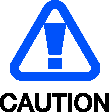
Safety precautions
Drive safely at all times
Avoid using your phone while driving and obey all regulations that restrict the use of
mobile phones while driving. Use hands-free accessories to increase your safety
when possible.
Follow all safety warnings and regulations
Comply with any regulations that restrict the use of a mobile phone in a certain area.
Use only Samsung-approved accessories
Using incompatible accessories may damage your phone or cause injury.
Turn off the phone near medical equipment
Your phone can interfere with medical equipment in hospitals or health care facilities.
Follow all regulations, posted warnings, and directions from medical personnel.
Turn off the phone or disable the wireless functions when in an aircraft
Your phone can cause interference with aircraft equipment. Follow all airline
regulations and turn off your phone or switch to a mode that disables the wireless
functions when directed by airline personnel.
Protect batteries and chargers from damage
Avoid exposing batteries to very cold or very hot temperatures (below 0° C/32° F or
above 45° C/ 113° F). Extreme temperatures can reduce the charging capacity and
life of your batteries.
Prevent batteries from contacting metal objects, as this can create a connection
between the + and - terminals of your batteries and lead to temporary or permanent
battery damage.
Never use a damaged charger or battery.
Handle your phone carefully and sensibly
Do not allow your phone to get wet—liquids can cause serious damage. Do not
handle your phone with wet hands. Water damage to your phone can void your
manufacturer’s warranty.
Avoid using or storing your phone in dusty, dirty areas to prevent damage to
moving parts.
Your phone is a complex electronic device— protect it from impacts and
rough handling to avoid serious damage.
Do not paint your phone, as paint can clog moving parts and prevent proper
operation.
Avoid using the phone’s camera flash or light close to the eyes of children or
animals.
Your phone and memory cards may be damaged by exposure to magnetic
fields. Do not use carrying cases or accessories with magnetic closures or
allow your phone to come in contact with magnetic fields for extended

periods of time.
Avoid interference with other electronic devices
Your phone emits radio frequency (RF) signals that may interfere with unshielded or
improperly shielded electronic equipment, such as pacemakers, hearing aids,
medical devices, and other electronic devices in homes or vehicles. Consult the
manufacturers of your electronic devices to solve any interference problems you
experience.
Important usage information
Use your phone in the normal position
Avoid contact with your phone’s internal antenna.
Allow only qualified personnel to service your phone
Allowing unqualified personnel to service your phone may result in damage to your
phone and will void your warranty.
Ensure maximum battery and charger life
Avoid charging batteries for more than a week, as overcharging may shorten
battery life.
Over time, unused batteries will discharge and must be recharged before use.
Disconnect chargers from power sources when not in use.
Use batteries only for their intended purpose.
Handle SIM cards and memory cards with care
Do not remove a card while the phone is transferring or accessing
information, as this could result in loss of data and/or damage to the card or
phone.
Protect cards from strong shocks, static electricity, and electrical noise from
other devices.
Frequent writing and erasing will shorten the life span of memory cards.
Do not touch gold-coloured contacts or terminals with your fingers or metal
objects. If dirty, wipe the card with a soft cloth.
Ensure access to emergency services
Emergency calls from your phone may not be possible in some areas or
circumstances. Before travelling in remote or undeveloped areas, plan an alternate
method of contacting emergency services personnel.

Health and safety information
Ex posure t o Radio Frequency ( RF) Signa ls
Cer t ifica t ion I nfor m at ion ( SAR)
Your wireless phone is a radio t ransm itt er and receiver . I t is designed and
m anufactured not to exceed t he exposure lim it s for radio frequency ( RF)
energy set by the Federal Com m unicat ions Com m ission (FCC) of the U.S.
governm ent. These FCC exposure lim its are derived from the
recom m endations of two expert organizations, t he Nat ional Counsel on
Radiation Prot ect ion and Measurem ent ( NCRP) and t he I nst itut e of
Elect rical and Electronics Engineers (I EEE). I n bot h cases, the
recom m endations w ere developed by scient ific and engineering expert s
drawn from indust ry, governm ent , and academ ia after extensive reviews
of the scientific liter ature relat ed to t he biological effect s of RF energy.
The exposure lim it set by the FCC for wireless m obile phones em ploys a
unit of m easurem ent known as t he Specific Absorpt ion Rat e ( SAR). The
SAR is a m easure of the rate of absorpt ion of RF energy by t he hum an
body expressed in units of wat t s per kilogram (W/ kg) . The FCC requires
wireless phones to com ply wit h a safet y lim it of 1.6 wat ts per kilogram
( 1.6 W/ kg) . The FCC exposure lim it incorporat es a subst ant ial m argin of
safety t o give addit ional protect ion to t he public and t o account for any
variations in m easurem ent s.
SAR t est s are conduct ed using st andard operating posit ions accept ed by
the FCC with t he phone transm it t ing at its highest cert ified power level in
all t est ed frequency bands. Although t he SAR is determ ined at the highest
cert ified power level, t he act ual SAR lev el of the phone while operat ing
can be well below t he m axim um value. This is because the phone is
designed to operate at m ultiple power levels so as to use only t he power
required t o reach t he netw ork. I n general, t he closer you are to a wireless
base st ation ant enna, the lower t he power output.
Before a new m odel phone is available for sale to t he public, it m ust be
test ed and cert ified to t he FCC t hat it does not exceed t he exposure lim it
est ablished by t he FCC. Test s for each m odel phone are perform ed in
positions and locations ( e.g. at t he ear and worn on t he body) as required
by the FCC.
For body w orn operation, t his m odel phone has been t ested and m eets
the FCC RF exposure guidelines when used with a Sam sung accessory
designated for t his product or when used wit h an accessory t hat contains
no m etal and t hat positions the handset a m inim um of 1.0 cm from the
body.
Non-com pliance wit h t he above rest rictions m ay result in violation of FCC
RF exposure guidelines.
SAR inform at ion on t his and ot her m odel phones can be viewed on-line at
http://www.fcc.gov/oet/ea/fccid/. Please use t he phone FCC I D num ber for

search, A3LGTB7810. Som etim es it m ay be necessary to remove t he
battery pack t o find the num ber. Once you have t he FCC I D num ber for a
part icular phone, follow the inst ruct ions on t he website and it should
provide values for t ypical or m axim um SAR for a part icular phone.
Addit ional product specific SAR inform at ion can also be obtained at
www.fcc.gov/ cgb/ sar.
Consu m er I nform at ion on W ire less Phones
The U.S. Food and Drug Adm inist rat ion (FDA) has published a series of
Quest ions and Answers for consum ers relating t o radio frequency ( RF)
exposur e from wireless phones. The FDA publicat ion includes the
following inform at ion:
W ha t k in ds of phones are t he subj e ct of t his upda t e ?
The t erm wireless phone refers here to hand-held wireless phones wit h
built-in ant ennas, oft en called “ cell,” “ m obile,” or “ PCS” phones. These
types of wireless phones can expose the user to m easurable radio
frequency energy ( RF) because of the short dist ance bet w een the phone
and t he user's head. These RF exposures are lim ited by Federal
Com m unicat ions Com m ission safet y guidelines t hat were developed w ith
the advice of FDA and other federal healt h and safety agencies. When the
phone is locat ed at greater dist ances from the user, t he exposure to RF is
drastically lower because a person's RF exposure decreases rapidly with
increasing dist ance from the source. The so-called “ cordless phones,”
which have a base unit connected to t he t elephone wiring in a house,
typically operate at far lower power levels, and t hus produce RF
exposures well wit hin t he FCC's com pliance lim it s.
Do w ir eless phone s pose a he alt h hazard?
The available scient ific evidence does not show that any healt h problem s
are associated wit h using wireless phones. There is no proof, however,
that w ireless phones ar e absolut ely safe. Wireless phones em it low levels
of radio frequency energy ( RF) in t he m icrowave range while being used.
They also em it ver y low levels of RF w hen in the st and-by m ode. Whereas
high levels of RF can produce healt h effect s (by heat ing t issue), exposure
to low level RF t hat does not produce heating effects causes no known
adverse healt h effect s. Many studies of low level RF exposures have not
found any biological effect s. Som e st udies have suggest ed that som e
biological effect s m ay occur, but such findings have not been confirm ed
by addit ional research. I n som e cases, other researchers have had
difficulty in reproducing t hose st udies, or in determ ining t he reasons for
inconsist ent results.
W ha t is FDA's r ole concer ning t he safe t y of w ir eless phone s?
Under the law, FDA does not review t he safet y of radiation-em itt ing
consum er product s such as wireless phones before they can be sold, as it
does wit h new drugs or m edical devices. However, t he agency has
aut hority to t ake act ion if wireless phones are shown t o em it radio
frequency energy ( RF) at a level t hat is hazardous to t he user. I n such a
case, FDA could require t he m anufact ur ers of wireless phones t o not ify
users of the healt h hazard and to repair, replace or recall t he phones so
that the hazard no longer exists.
Alt hough t he exist ing scient ific dat a do not j ustify FDA regulatory act ions,
FDA has urged t he wireless phone indust ry t o t ake a num ber of st eps,
including t he following:
“ Support needed research int o possible biological effect s of RF of
the t ype em it t ed by wireless phones;
“ Design wireless phones in a way that m inim izes any RF exposure
to t he user t hat is not necessary for device function; and
“ Cooperate in pr oviding users of wireless phones with t he best
possible inform at ion on possible effect s of wireless phone use on
hum an health.
FDA belongs t o an int eragency working group of the feder al agencies t hat
have responsibility for different aspect s of RF safety t o ensure coordinated
effort s at the federal level. The following agencies belong t o this working
group:
“ Nat ional I nst itute for Occupational Safety and Healt h
“ Environm ental Prot ect ion Agency
“ Federal Com m unicat ions Com m ission
“ Occupational Safety and Healt h Adm inistrat ion
“ Nat ional Telecom m unicat ions and I nform at ion Adm inist rat ion
The Nat ional I nst it ut es of Health par ticipat es in som e inter agency working
group act ivit ies, as well.
FDA shares regulatory responsibilit ies for w ireless phones wit h t he Federal
Com m unicat ions Com m ission ( FCC). All phones t hat are sold in t he Unit ed
St ates m ust com ply with FCC safety guidelines t hat lim it RF exposure.
FCC relies on FDA and ot her healt h agencies for safety quest ions about
wireless phones.
FCC also regulates t he base st ations t hat t he wireless phone net works
rely upon. While t hese base st ations operat e at higher power t han do t he
wireless phones t hem selves, the RF exposures that people get from these
base st ations are typically t housands of t im es lower than those t hey can
get from wireless phones. Base st ations are thus not the prim ary subj ect
of the safety quest ions discussed in this docum ent .
W ha t a re t he r esu lt s of t h e resea r ch done a lre a dy?
The research done t hus far has produced conflict ing results, and m any
studies have suffered from flaws in t heir research m ethods. Anim al
experim ent s invest igat ing t he effect s of radio frequency energy ( RF)
exposures characterist ic of wireless phones have yielded conflicting
results t hat often cannot be repeated in ot her laboratories. A few anim al
studies, however , have suggest ed that low levels of RF could accelerate
the developm ent of cancer in laboratory anim als. However, m any of t he
studies that showed increased tum or developm ent used anim als t hat had
been genet ically engineered or t reated with cancer-causing chem icals so
as to be pre-disposed t o develop cancer in absence of RF exposure. Ot her
studies exposed t he anim als t o RF for up t o 22 hours per day. These
conditions are not sim ilar t o the conditions under which people use
wireless phones, so we don't know with cert aint y what t he result s of such
studies m ean for hum an healt h.
Three large epidem iology st udies have been published since Decem ber
2000. Between t hem , t he st udies invest igat ed any possible associat ion
between the use of wireless phones and prim ary brain cancer, gliom a,
m eningiom a, or acoust ic neurom a, t um ors of the brain or salivary gland,
leukem ia, or other cancers. None of t he st udies dem onstrat ed t he
exist ence of any harm ful health effect s from wireless phones RF
exposur es. However, none of the st udies can answer quest ions about
long-term exposures, since t he average period of phone use in t hese
studies was around three years.
W ha t re sea rch is ne eded t o decide w het her RF e xposure fr om
w ir eless phone s poses a h ealt h risk ?
A com bination of laboratory studies and epidem iological st udies of people
act ually using wireless phones w ould provide som e of t he data t hat are
needed. Lifet im e anim al exposure st udies could be com pleted in a few
years. How ever , very large num bers of anim als would be needed t o
provide reliable proof of a cancer prom ot ing effect if one exist s.
Epidem iological st udies can pr ovide dat a t hat is direct ly applicable t o
hum an populations, but ten or m ore years' follow-up m ay be needed t o
provide answers about som e health effects, such as cancer. This is
because the int erval between t he t ime of exposure t o a cancer-causing
agent and the t im e t um ors develop - if t hey do - m ay be m any, m any
years. The int erpretation of epidem iological st udies is ham pered by
difficulties in m easuring act ual RF exposure during day-t o-day use of
wireless phones. Many factors affect this m easurem ent , such as the angle
at which t he phone is held, or which m odel of phone is used.
W ha t is FDA doing t o find out m ore a bout t he possible hea lt h
effe ct s of w ir eless phone RF?
FDA is working with the U.S. Nat ional Toxicology Program and with
groups of invest igat ors around t he world to ensure that high priority
anim al st udies are conduct ed to address im portant quest ions about t he
effect s of exposure t o radio frequency ener gy (RF).
FDA has been a leading part icipant in the World Health Or ganizat ion
int ernational Elect rom agnetic Fields ( EMF) Proj ect since it s incept ion in
1996. An influent ial result of t his wor k has been the developm ent of a
detailed agenda of r esearch needs t hat has driven t he est ablishm ent of
new research program s around t he world. The Proj ect has also helped
develop a series of public inform at ion docum ent s on EMF issues.
FDA and Cellular Telecom m unicat ions & I nt ernet Association ( CTI A) have
a form al Cooperative Resear ch and Developm ent Agreem ent ( CRADA) to
do research on wireless phone safet y. FDA provides t he scient ific
oversight, obtaining input from expert s in governm ent , industry, and
academ ic organizations. CTI A-funded research is conduct ed through
contr act s to independent invest igat ors. The init ial research will include
bot h laboratory studies and st udies of wireless phone users. The CRADA
will also include a broad assessm ent of addit ional research needs in the
cont ext of t he lat est research developm ent s around t he world.
W hat steps can I tak e to r educe m y exposur e t o ra dio fr equency
ener gy from m y w ir eless phone?
I f there is a risk from these product s - and at t his point we do not know
that there is - it is probably very sm all. But if you are concerned about
avoiding even pot ential risks, you can take a few sim ple steps to m inim ize
your exposure t o radio frequency energy ( RF) . Since t im e is a key factor
in how m uch exposure a person receives, reducing t he am ount of t im e
spent using a wireless phone will reduce RF exposure.
“ I f you m ust conduct extended conversat ions by wireless phone
every day, you could place m ore dist ance between your body and
the source of the RF, since t he exposure level drops off
dram atically wit h dist ance. For exam ple, you could use a headset
and carry t he wireless phone away from your body.
Again, t he scient ific data do not dem onst rat e t hat w ireless phones are
harm ful. But if you are concerned about the RF exposur e fr om these
product s, you can use m easures like t hose described above t o reduce
your RF exposure from wireless phone use.
W ha t a bout ch ildren using w ir eless phones?
The scient ific evidence does not show a danger to users of wireless
phones, including children and t eenagers. I f you want t o t ake st eps t o
lower exposure t o radio frequency energy ( RF) , t he m easures described
above would apply t o children and t eenagers using w ireless phones.
Reducing t he t im e of wireless phone use and increasing t he dist ance
between the user and the RF source will reduce RF exposure.
Som e groups sponsored by ot her nat ional governm ent s have advised t hat
children be discouraged from using wireless phones at all. For exam ple,
the governm ent in t he Unit ed Kingdom dist ribut ed leaflet s containing such
a recom m endation in Decem ber 2000. They noted t hat no evidence exist s
that using a wireless phone causes brain t um ors or other ill effect s. Their
recom m endat ion to lim it wireless phone use by children was st rict ly
precaut ionary; it was not based on scientific evidence t hat any healt h
hazard exist s.
Do hands-fr ee k it s for w ir eless phones re duce risk s fr om exposure
t o RF em issions?
Since t here are no known risks from exposure to RF em issions from
wireless phones, there is no reason t o believe t hat hands-free kits reduce
risks. Hands-free kit s can be used wit h wireless phones for convenience
and com fort . These system s reduce the absorpt ion of RF energy in t he
head because the phone, which is t he source of the RF em issions, will not
be placed against t he head. On t he other hand, if t he phone is m ount ed
against t he waist or other part of t he body during use, t hen that part of
the body will absorb m ore RF ener gy. Wireless phones m arketed in t he
U.S. are required t o m eet safet y requirem ents regardless of whether t hey
are used against the head or against the body. Either configurat ion should
result in com pliance with t he safety lim it .
Do w ir eless phone a ccessories t hat claim t o shield t h e head from
RF ra dia t ion w ork?
Since t here are no known risks from exposure to RF em issions from
wireless phones, there is no reason to believe t hat accessories that claim
to shield t he head from those em issions reduce risks. Som e product s t hat
claim t o shield t he user from RF absorption use special phone cases, while
others involve not hing m ore than a m et allic accessory attached t o the
phone. St udies have shown that t hese product s generally do not work as
advertised. Unlike “ hand-free” kits, t hese so-called “ shields” m ay interfere
wit h proper operation of t he phone. The phone m ay be forced to boost its
power t o com pensate, leading t o an increase in RF absorpt ion. I n
February 2002, t he Federal t rade Comm ission (FTC) charged two
com panies t hat sold devices t hat claim ed t o protect wireless phone users
from radiation wit h m aking false and unsubstant iat ed claim s. Accor ding t o
FTC, these defendant s lacked a reasonable basis to subst antiate their
claim .
W ha t a bout w ire less phone int er fer ence w it h m edical equipm ent ?
Radio frequency energy (RF) from wireless phones can interact wit h som e
elect ronic devices. For this reason, FDA helped develop a det ailed t est
m et hod t o m easure elect rom agnet ic int erference ( EMI ) of im plant ed
cardiac pacem akers and defibrillators fr om wireless telephones. This t est
m et hod is now part of a st andard sponsored by t he Association for t he
Advancem ent of Medical inst rum ent at ion ( AAMI ) . The final draft, a j oint
effort by FDA, m edical device m anufact urers, and m any ot her groups,
was com pleted in late 2000. This st andard will allow m anufact urers t o
ensure that cardiac pacem akers and defibrillators are safe from wireless
phone EMI . FDA has t est ed wireless phones and helped develop a
volunt ary st andard sponsored by t he I nst it ut e of Elect rical and Electr onic
Engineers ( I EEE) . This st andard specifies t est m ethods and perform ance
requirem ent s for hearing aids and wireless phones so t hat no interference
occur s when a person uses a com pat ible phone and a com patible hearing
aid at t he sam e tim e. This standard was approved by t he I EEE in 2000.
FDA continues t o m onitor t he use of wireless phones for possible
int eractions wit h ot her m edical devices. Should harm ful int erference be
found t o occur, FDA will conduct test ing to assess the int erference and
work t o resolve the problem .
Addit ional inform ation on the safety of RF exposures from various sources
can be obt ained from the following organizat ions:
FCC RF Safety Program :

ht t p: / / www.fcc.gov/ oet/ rfsafety/
Environm ent al Prot ect ion Agency ( EPA) :
ht t p: / / www.epa.gov/ radiation/
Occupational Safety and Healt h Adm inist rat ion's ( OSHA) :
ht t p: / / www.osha.gov/ SLTC/ radiofrequencyradiation/ index.ht m l
National inst it ute for Occupational Safety and Healt h ( NI OSH):
ht t p: / / www.cdc.gov / niosh/ em fpg.ht m l
World health Organization ( WHO) :
http: / / w ww.who.int / peh-em f/
I nternat ional Com m ission on Non-I onizing Radiat ion Prot ect ion:
ht t p: / / www.icnirp.de
National Radiation Protect ion Board ( UK) :
ht t p: / / www.nrpb.org.uk
Updated 4/ 3/ 2002: US food and Drug Adm inist rat ion
http://www.fda.gov/Radiation-
EmittingProducts/RadiationEmittingProductsandProcedures/HomeBusinessandEntertainment
/CellPhones/default.htm
Road Safet y
Your wireless phone gives you the powerful ability t o com m unicate by
voice, alm ost anyw here, anyt im e. But an im portant responsibilit y
accom panies t he benefits of wireless phones, one t hat every user m ust
uphold.
When driving a car, driving is your first responsibilit y. When using your
wireless phone behind the wheel of a car, pract ice good com m on sense
and rem em ber the following tips:
1. Get t o know your wireless phone and it s feat ures, such as speed
dial and redial. I f available, t hese features help you to place your
call wit hout t aking your attention off the road.
2. When available, use a hands-free device. I f possible, add an
addit ional layer of convenience and safet y t o your wireless phone
with one of t he m any hands free accessories available today.
3. Posit ion your wireless phone wit hin easy reach. Be able to access
your w ireless phone without rem oving your eyes from the road. I f
you get an incom ing call at an inconvenient t im e, let your voice
m ail answer it for you.
4. Let t he person you are speaking wit h know you are driving; if
necessary, suspend t he call in heavy traffic or hazardous weat her
condit ions. Rain, sleet, snow, ice and even heavy t raffic can be
hazardous.
5. Do not t ake notes or look up phone num bers while driving. Jotting
down a “ t o do” list or flipping t hrough your address book t akes
att ention away from your prim ary responsibility, driving safely.
6. Dial sensibly and assess the t raffic; if possible, place calls when
you are not m oving or before pulling int o traffic. Try t o plan calls

when your car will be st ationary. I f you need t o m ake a call while
m oving, dial only a few num bers, check t he road and your m irrors,
then continue.
7. Do not engage in st ressful or em otional conversations t hat m ay be
dist ract ing. Make people you are talking wit h aware you are driving
and suspend conversations t hat have t he potent ial t o divert your
att ent ion from the r oad.
8. Use your wireless phone t o call for help. Dial 9- 1- 1 or other local
em ergency num ber in t he case of fire, t raffic accident or m edical
em ergencies. Rem em ber, it is a free call on your wireless phone!
9. Use your wireless phone t o help ot hers in em ergencies. I f you see
an aut o accident , cr im e in progress or other serious em ergency
where lives are in danger, call 9- 1-1 or ot her local em ergency
num ber, as you would want others to do for you.
10. Call roadside assist ance or a special non-em ergency wireless
assist ance num ber when necessary. I f you see a broken-down
vehicle posing no serious hazard, a broken t raffic signal, a m inor
traffic accident where no one appears inj ured, or a vehicle you
know t o be st olen, call roadside assist ance or other special non-
em ergency num ber.
“The w ir eless industry rem inds you t o use your phone safe ly w hen
driving.”
For m or e infor m at ion, plea se call 1 -888-901-SAFE, or visit our
w eb-sit e w w w .w ow -com .com
Provided by t he Ce llular Te lecom m unicat ions & I nt ernet
Associa t ion
Ope rat ing Environm ent
Rem em ber to follow any special regulations in force in any area and
always swit ch your phone off whenever it is forbidden to use it, or when it
m ay cause interference or danger. When connect ing the phone or any
accessory to anot her device, read its user's guide for detailed safety
inst ruct ions. Do not connect incom patible product s.
As wit h ot her m obile radio t ransm itt ing equipm ent , users are advised that
for t he satisfact ory operation of the equipm ent and for t he safet y of
personnel, it is recom m ended t hat t he equipm ent should only be used in
the norm al operat ing posit ion.
Using Your Phone N ear Ot her Elect r onic Devices
Most m odern elect ronic equipm ent is shielded from radio fr equency ( RF)
signals. However, cert ain elect ronic equipm ent m ay not be shielded
against t he RF signals from your wireless phone. Consult t he
m anufacturer to discuss alternat ives.
Pacem a k er s
Pacem aker m anufact urers recom m end t hat a m inim um dist ance of 15 cm
( 6 inches) be m aint ained between a wireless phone and a pacem aker t o
avoid potent ial interference wit h t he pacem aker.

These recom m endations are consistent wit h the independent research
and recom m endations of Wireless Technology Research.
Persons w it h pa cem aker s:
should always keep the phone m ore than 15 cm
( 6 inches) from t heir pacem aker when t he phone is switched on.
should not carry t he phone in a breast pocket.
should use t he ear opposit e t he pacem aker t o m inim ize potential
interference.
I f you have any reason to suspect t hat int erference is taking place, switch
your phone off im m ediately.
Hea r ing Aids
Som e digital wireless phones m ay int erfere with som e hearing aids. I n t he
event of such int erference, you m ay wish t o consult your hearing aid
m anufacturer to discuss alternat ives.
Ot he r Medica l D evices
I f you use any ot her personal m edical devices, consult t he m anufact urer
of your device to det erm ine if it is adequately shielded from exter nal RF
energy. Your physician m ay be able t o assist you in obtaining this
inform ation. Sw it ch your phone off in healt h care facilit ies when any
regulations post ed in t hese areas inst ruct you t o do so. Hospitals or
health care facilit ies m ay be using equipm ent that could be sensit ive t o
ext ernal RF energy.
Vehicle s
RF signals m ay affect im properly installed or inadequately shielded
elect ronic syst em s in m ot or vehicles. Check with t he m anufact urer or its
represent ative regarding your vehicle. You should also consult the
m anufacturer of any equipm ent t hat has been added t o your vehicle.
Post ed Fa cilit ie s
Switch your phone off in any facilit y where post ed not ices require you t o
do so.
Pot ent ia lly Explosive Envir onm e nt s
Switch your phone off when in any area wit h a potent ially explosive
atm osphere and obey all signs and inst ruct ions. Sparks in such areas
could cause an explosion or fire resulting in bodily inj ury or even deat h.
Users are advised t o swit ch t he phone off while at a refueling point
(service stat ion). Users are rem inded of the need to observe restrict ions
on the use of radio equipm ent in fuel depots ( fuel st orage and distribut ion
areas) , chem ical plant s or where blasting operations are in progress.
Areas wit h a pot ent ially explosive at m osphere are oft en but not alw ays
clearly m arked. They include below deck on boats, chem ical t ransfer or
storage facilit ies, vehicles using liquefied pet roleum gas (such as propane
or but ane), areas where the air contains chem icals or part icles, such as
grain, dust or m et al powders, and any ot her area where you would
norm ally be advised t o t urn off your vehicle engine.

Em erge ncy Calls
This phone, like any wireless phone, operat es using radio signals, wireless
and landline networks as well as user program m ed funct ions, which
cannot guarant ee connect ion in all condit ions. Therefore, you should
never rely solely on any wireless phone for essent ial com m unicat ions
( m edical em ergencies, for exam ple) .
Rem em ber, to m ake or receive any calls the phone m ust be swit ched on
and in a service area with adequate signal strength. Em ergency calls m ay
not be possible on all wireless phone netw orks or when cert ain network
services and/ or phone feat ures are in use. Check wit h local service
providers.
To m ake an em ergency call:
1. I f t he phone is not on, switch it on.
2. Key in the em ergency num ber for your present locat ion ( for
exam ple, 911 or other official em ergency num ber) . Em ergency
num bers vary by location.
3. Press .
I f certain features are in use ( call barring, for exam ple) , you m ay first
need to deact ivate those feat ures before you can m ake an em ergency call.
Consult t his docum ent and your local cellular service provider.
When m aking an em ergency call, rem em ber t o give all the necessary
inform ation as accurat ely as possible. Rem em ber that your phone m ay be
the only m eans of com m unicat ion at t he scene of an accident ; do not cut
off t he call unt il given perm ission to do so.
Rest rict ing Children's acce ss t o you r Phone
Your phone is not a t oy. Children should not be allow ed t o play with it
because they could hurt t hem selves and ot hers, dam age t he phone or
m ake calls t hat increase your phone bill.

FCC N ot ice a nd Ca ut ions
FCC N ot ice
This device com plies wit h Part 15 of t he FCC Rules. Oper ation is
subj ect t o t he following two conditions: ( 1) t his device m ay not cause
harm ful int erference, and ( 2) t his device m ust accept any interference
received, including interference t hat m ay cause undesired operation.
This equipm ent has been test ed and found t o com ply w ith t he
lim it s for a Class B digital device, pursuant t o part 15 of t he FCC
Rules. These lim its are designed t o provide r easonable protect ion
against harm ful int erference in a residential inst allation. This
equipm ent generates, uses and can radiat e radio frequency energy
and, if not installed and used in accor dance with t he inst ruct ions,
m ay cause harm ful int erference t o radio com m unicat ions. However,
there is no guarantee that int erfer ence will not occur in a part icular
inst allation. I f this equipm ent does cause harm ful int erference t o
radio or t elevision r ecept ion, which can be det erm ined by t urning
the equipm ent off and on, t he user is encouraged to t ry t o correct
the int erference by one or m ore of t he following m easures:
-Reorient or relocate t he receiving antenna.
-I ncrease t he separation bet ween the equipm ent and receiver.
-Connect t he equipm ent into an outlet on a circuit different from that to
which t he receiver is connected.
-Consult t he dealer or an experienced radio/ TV t echnician for help.
The phone m ay cause TV or radio interference if used in close proxim ity
to receiving equipm ent . The FCC can require you to st op using the phone
if such int erference cannot be elim inated.
Vehicles using liquefied petroleum gas ( such as propane or butane) m ust
com ply wit h the Nat ional Fire Prot ection Standard (NFPA-58) . For a copy
of this st andard, cont act t he Nat ional Fire Protection Associat ion, One
Battery m arch Park, Quincy, MA 02269, At t n: Publication Sales Division.
Ca ut ions
Changes or m odifications m ade in t he radio phone, not expressly
approved by Sam sung, will void the user’s aut hority to operat e t he
equipm ent .
The use of any unauthorized accessories m ay be dangerous and void t he
phone warranty if said accessories cause dam age or a defect t o the phone.
Alt hough your phone is quite sturdy, it is a com plex piece of equipm ent
and can be broken. Avoid dropping, hitting, bending or sit t ing on it.

Ot her I m port ant Sa fet y I nform a t ion
Only qualified personnel should service t he phone or inst all t he
phone in a vehicle. Faulty inst allat ion or service m ay be dangerous
and m ay invalidat e any warrant y applicable t o t he device.
Check regularly t hat all wir eless phone equipm ent in your vehicle is
m ounted and operating properly.
Do not store or carry flam m able liquids, gases or explosive
m at erials in t he sam e com part m ent as t he phone, its par t s or
accessories.
For vehicles equipped with an air bag, rem em ber t hat an air bag
inflates wit h great force. Do not place obj ect s, including bot h
inst alled or portable wireless equipm ent in t he area over the air
bag or in t he air bag deploym ent area. I f wireless equipm ent is
im properly inst alled and t he air bag inflates, serious inj ury could
result.
Switch your phone off before boarding an aircraft . The use of
wireless phone in aircraft is illegal and m ay be dangerous t o the
aircraft's operation.
Failure to observe these inst ruct ions m ay lead t o the suspension or
denial of t elephone services t o the offender, or legal act ion, or bot h.
Product Perfor m ance
Get t in g t he Most Out of Your Signa l Re ce pt ion
The quality of each call you m ake or receive depends on t he signal
strengt h in your area. Your phone infor m s you of t he current signal
strength by displaying a num ber of bars next t o the signal st rength icon.
The m ore bars displayed, the stronger the signal.
I f you're inside a building, being near a w indow m ay give you bett er
reception.
Unde rst a nding t he Pow er Sa ve Fea t ur e
I f your phone is unable t o find a signal after 15 m inut es of searching, a
Power Save feat ure is aut om atically act ivat ed. I f your phone is act ive, it
periodically rechecks service availability or you can check it yourself by
pressing any key.
Anyt im e t he Power Save feature is act ivated, a m essage displays on the
screen. When a signal is found, your phone returns to st andby m ode.
Maint a ining Your Phone 's Peak Perfor m a nce
For the best care of your phone, only authorized personnel should service
your phone and accessories. Fault y service m ay void t he warranty.
There are several sim ple guidelines t o operating your phone properly and
m aint aining safe, sat isfact ory service.
Place the m obile phone's acoust ic out put next to your ear for
proper orient ation.
Do not t am per or alter the phone's ant enna.

Don't use t he phone if t he ant enna is dam aged.
Speak direct ly int o t he phone's receiver.
Avoid exposing your phone and accessories t o rain or liquid spills.
I f your phone does get wet, im m ediately turn t he power off and
rem ove t he battery. I f it is inoperable, call Cust om er Care for
service.
Ava ila bilit y of Various Fea t ur es/ Rin g Tones
Many services and features are net work dependent and m ay require
addit ional subscription and/ or usage charges. Not all feat ures are
available for purchase or use in all areas. Downloadable Ring Tones m ay
be available at an additional cost. Other condit ions and r est rictions m ay
apply. See your service provider for additional inform ation.
Ba t t er y St a ndby and Talk Tim e
St andby and t alk tim es will vary depending on phone usage patt erns and
conditions. Bat t ery power consum pt ion depends on fact ors such as
net work configurat ion, signal strengt h, operating tem per ature, features
select ed, frequency of calls, and voice, data, and ot her applicat ion usage
patterns.
Ba t t ery Precaut ions
Never use any charger or batt ery that is dam aged in any w ay.
Use t he bat tery only for its intended purpose.
I f you use t he phone near the network's base st at ion, it uses less
power; t alk and st andby t im e are great ly affect ed by t he signal
strength on t he cellular network and t he param eters set by the
network operator.
Batt ery charging t im e depends on t he rem aining bat tery charge
and t he t ype of batter y and charger used. The bat tery can be
charged and discharged hundreds of tim es, but it w ill gradually
wear out . When the operation t im e (talk t im e and st andby t im e) is
not iceably short er t han norm al, it is t im e to buy a new battery.
I f left unused, a fully charged battery will discharge itself over t im e.
Use only Sam sung-approved bat t eries and recharge your bat t ery
only wit h Sam sung-approved chargers. When a charger is not in
use, disconnect it from the power sour ce. Do not leave t he bat tery
connect ed to a charger for m ore than a week, since overcharging
m ay short en its life.
Extrem e t em perat ur es will affect t he charging capacit y of your
battery: it m ay require cooling or warm ing first .
Do not leave t he batter y in hot or cold places, such as in a car in
sum m er or winter condit ions, as you will reduce t he capacit y and
lifetim e of t he bat t ery. Always t ry to keep t he battery at room
tem perature. A phone with a hot or cold bat tery m ay tem porarily
not work, even when the bat t ery is fully charged. Li-ion bat teries
are part icularly affect ed by tem peratures below 0 ° C (32 ° F).

Do not short -circuit the battery. Accident al short - circuit ing can
occur when a m etallic object ( coin, clip or pen) causes a direct
connect ion bet ween the + and - t erm inals of the battery ( m et al
strips on t he bat t ery) , for exam ple when you carry a spare batt ery
in a pocket or bag. Short -circuit ing t he t erm inals m ay dam age t he
battery or the object causing t he short -cir cuit in g.
Dispose of used bat teries in accordance with local regulations. I n
som e areas, t he disposal of batteries in household or business
trash m ay be prohibited. For safe disposal options for Li-I on
batt eries, contact your nearest Sam sung aut horized service center.
Always recycle. Do not dispose of batter ies in a fire.
Car e and Maint en ance
Your phone is a product of superior design and craft sm anship and should
be t reat ed with care. The suggest ions below will help you fulfill any
warranty obligations and allow you to enjoy this product for m any years.
Keep the phone and all its part s and accessories out of t he reach of
sm all children.
Keep t he phone dry. Pr ecipit at ion, hum idity and liquids cont ain
m inerals t hat will corrode elect ronic circuits.
Do not use the phone with a w et hand. Doing so m ay cause an
elect ric shock to you or dam age t o t he phone.
Do not use or st ore t he phone in dust y, dirt y areas, as it s m oving
part s m ay be dam aged.
Do not st ore t he phone in hot areas. High tem peratures can
short en the life of elect ronic devices, dam age batteries, and warp
or m elt cert ain plast ics.
Do not store the phone in cold areas. When t he phone warm s up t o
its norm al operating tem perature, m oist ure can form inside the
phone, which m ay dam age t he phone's elect ronic circuit boards.
Do not drop, knock or shake the phone. Rough handling can break
int ernal circuit boards.
Do not use harsh chem icals, cleaning solvents or strong det ergent s
to clean t he phone. Wipe it w ith a soft clot h slightly dam pened in a
m ild soap-and-water solution.
Do not paint t he phone. Paint can clog t he device's m oving parts
and prevent proper oper ation.
Do not put the phone in or on heat ing devices, such as a
m icrowave oven, a stove or a radiator. The phone m ay explode
when overheated.
When t he phone or bat t ery get s w et, t he label indicat ing w ater
dam age inside t he phone changes color. I n t his case, phone repairs
are no longer guarant eed by t he m anufacturer's warranty, even if
the warrant y for your phone has not expired.
I f your phone has a flash or light, do not use it t oo close t o the
eyes of people or anim als. This m ay cause dam age t o their eyes.

Use only t he supplied or an approved replacem ent antenna.
Unaut horized antennas or m odified accessories m ay dam age the
phone and v iolat e regulations governing radio devices.
I f t he phone, battery, charger or any accessory is not working
properly, t ake it to your nearest qualified service facility. The
personnel there will assist you, and if necessary, arrange for
service.
Correct disposal of this product
(Waste Electrical & Electronic Equipment)
(Applicable in the European Union and other European countries with separate
collection systems)
This marking shown on the product or its literature, indicates that it should not be
disposed with other household wastes at the end of its working life. To prevent
possible harm to the environment or human health from uncontrolled waste disposal,
please separate this from other types of wastes and recycle it responsibly to promote
the sustainable reuse of material resources.
Household users should contact either the retailer where they purchased this product,
or their local government office, for details of where and how they can take this item
for environmentally safe recycling.
Business users should contact their supplier and check the terms and conditions of
the purchase contract. This product should not be mixed with other commercial
wastes for disposal.
Correct disposal of batteries in this product
(Applicable in the European Union and other European countries with separate
battery return systems)
This marking on the battery, manual or packaging indicates that the batteries in this
product should not be disposed of with other household waste at the end of their
working life. Where marked, the chemical symbols Hg, Cd or Pb indicate that the
battery contains mercury, cadmium or lead above the reference levels in EC
Directive 2006/66. If batteries are not properly disposed of, these substances can
cause harm to human health or the environment.
To protect natural resources and to promote material reuse, please separate
batteries from other types of waste and recycle them through your local, free battery
return system.
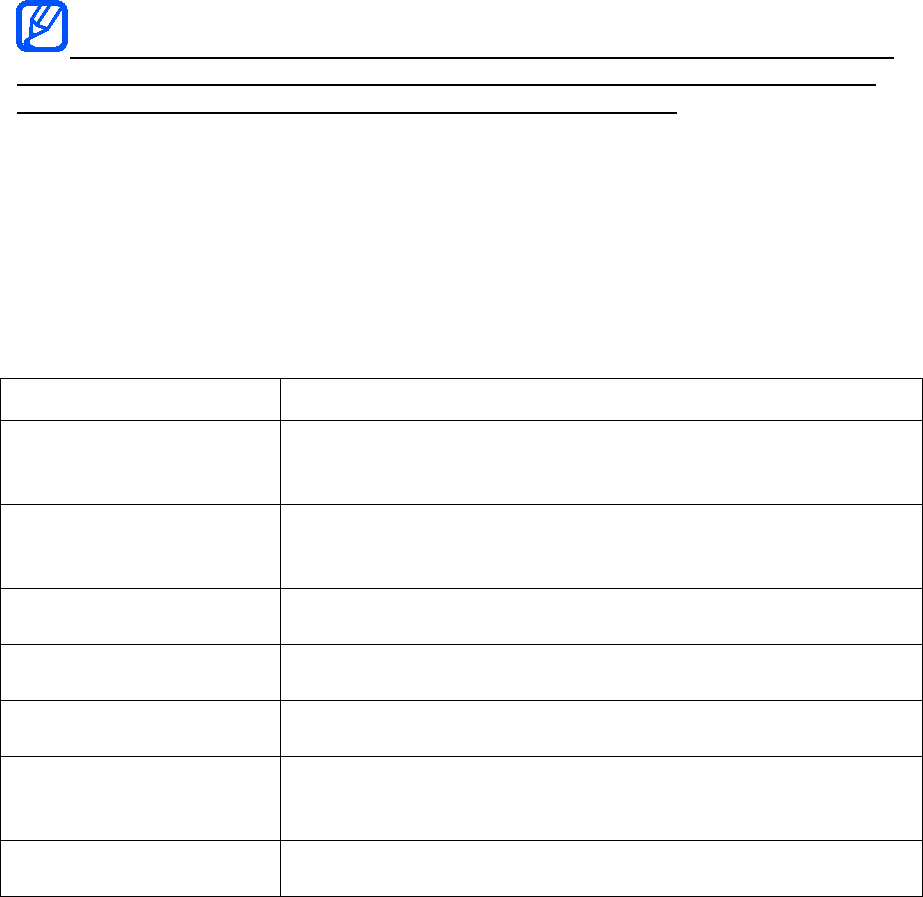
introducing your mobile
phone
In this section, learn about your mobile phone’s layout, keys, display, and icons
Unpack
Check your product box for the following items:
Mobile phone
Battery
Travel adapter (charger)
User manual
The items supplied with your phone may vary depending on the software and
accessories available in your region or offered by your service provider. You can
obtain additional accessories from your local Samsung dealer.
Phone layout
The front of your phone includes the following keys and features:
The rear of your phone includes the following keys and features:
Keys
Key Function
Softkeys
Perform actions indicated at the bottom of the display; In
Idle mode, press and hold the left softkey to access the
simplified menus
4-way navigation
In Idle mode, access user-defined menus
(left/right/up/down); In Menu mode, scroll through menu
options
Confirm
In Idle mode, launch the web browser; In Menu mode,
select the highlighted menu option or confirm an input
Dial
Make or answer a call; In Idle mode, retrieve recently
dialled, missed, or received numbers
Power/ Menu exit
Turn the phone on and off (press and hold); End a call; In
Menu mode, cancel input and return to Idle mode
Alpha-numeric
Enter numbers, letters and special characters; In Idle
mode, press and hold [1] to access voice mails and [0] to
enter an international call prefix
Special function
Enter special characters or perform special functions; In
Idle mode, press and hold [#] for the silent profile; Press
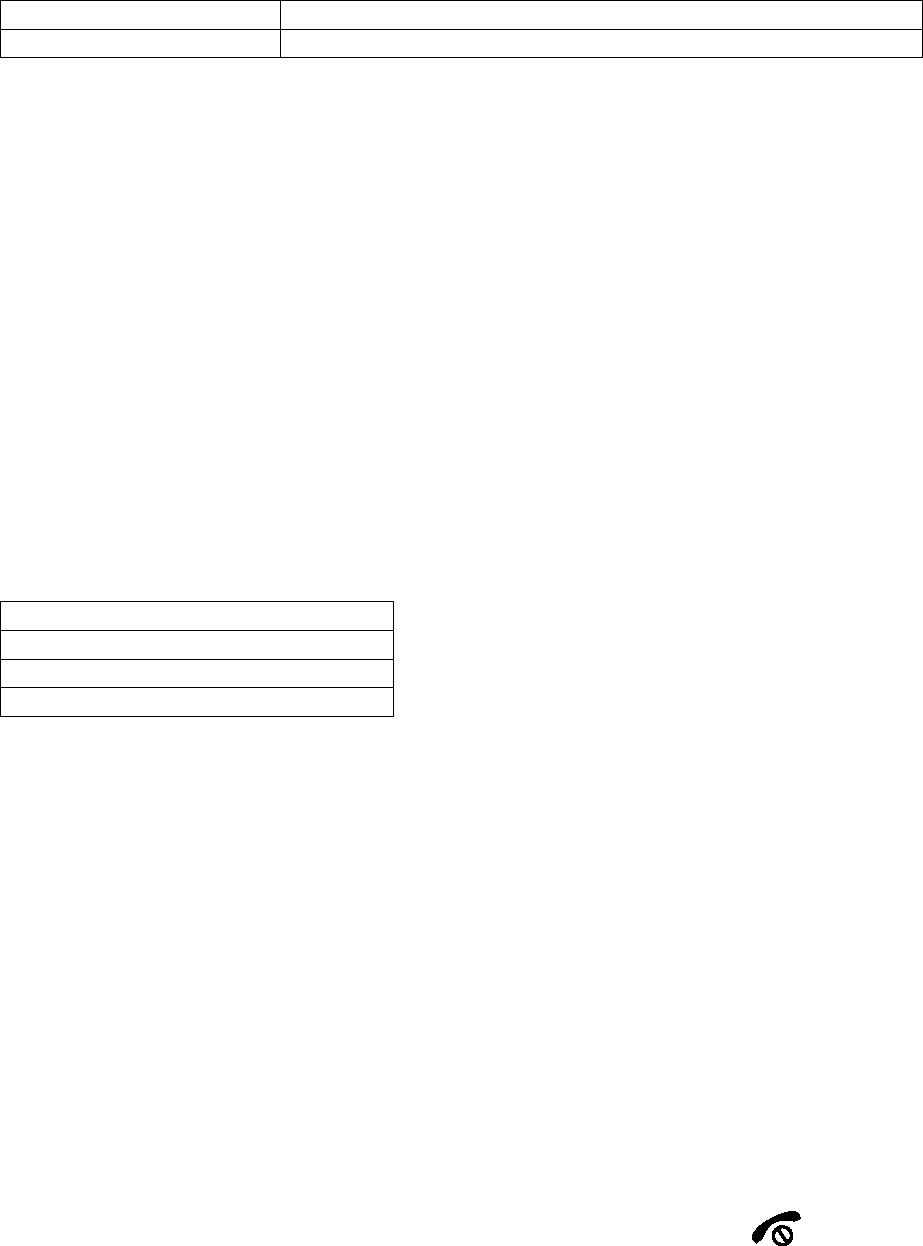
and hold [*] to enter a pause between numbers
Volume
Adjust the phone’s volume
Display
Your phone’s display consists of three areas:
Icon line
Displays various icons
Text and graphic area
Displays messages, instructions, and information you enter
Softkey line
Displays the current actions assigned to each softkey
Icons
Learn about the icons that appear on your display.
Definition
Signal strength
Call in progress
New text message
assembling and preparing
your mobile phone
Get started by assembling and setting up
your mobile phone for its first use.
Install the SIM card and battery
When you subscribe to a cellular service, you will receive a Subscriber Identity
Module, or SIM card, with subscription details, such as your personal identification
number (PIN) and optional services.
To install the SIM card and battery,
1. Remove the battery cover. If the phone is on, press and hold [ ] to turn it
off.
2. Insert the SIM card. Place the SIM card in the phone with the gold-coloured
contacts facing down.

3. Insert the battery.
4. Replace the battery cover.
Charge the battery
Before using the phone for the first time, you must charge the battery.
1. Open the cover to the multifunction jack on the side of the phone.
2. Plug the small end of the travel adapter into the multifunction jack. Improperly
connecting the travel adapter can cause serious damage to the phone. Any
damages by misuse are not covered by the warranty.
3. Plug the large end of the travel adapter into a power outlet.
4. When the battery is fully charged (the [|||||] icon is no longer moving), unplug
the travel adapter from the power outlet.
5. Unplug the travel adapter from the phone.
6. Close the cover to the multifunction jack.
About the low battery indicator
When your battery is low, the phone will emit a warning tone and a low battery
message. The battery icon will also be empty and blinking. If the battery level
becomes too low, the phone will automatically power off. Recharge your battery to
continue using your phone.
using basic functions
Learn how to perform basic operations and use the main features of your mobile
phone.
Turn your phone on and off
To turn your phone on,
1. Slide open the phone.
2. Press and hold [ ].
3. Enter your PIN and press <OK> (if necessary).
4. When the setup wizard opens, customise your phone as desired by following
the screen.
To turn your phone off, repeat steps 1 and 2 above.
Switch to the offline profile
By switching to the offline profile, you can use your phone’s non-network services in
areas where wireless devices are prohibited, such as aeroplane and hospitals.
To switch to the offline profile, in Menu mode, select Settings Õ Phone profiles Õ
Offline.

Follow all posted warnings and directions from official personnel when in areas
where wireless devices are prohibited.
Access menus
To access your phone’s menus,
1. In Idle mode, press <Menu> to access Menu mode.
2. Use the navigation key to scroll to a menu or option.
3. Press [OK], <Select>, or <Save> to confirm the highlighted option.
4. Press <Back> to move up one level; Press [ ] to return to Idle mode.
Customise your phone
Get more from your phone by customising it to match your preferences.
Adjust the volume of the key tones
In Idle mode, press the Volume key up or down to adjust the key tone volume.
Switch to or from the silent profile
In Idle mode, press and hold [#] to silence or unsilence your phone.
Change your ringtone
1. In Menu mode, select Settings Õ Phone profiles .
2. Scroll to the profile you are using.
3. Press <Options> Õ Edit Õ Voice call ringtone.
4. Select a ringtone category Õ a ringtone.
5. Press <Options> Õ Select (if necessary).
6. Press <Save>.
To switch to another profile, select it from the list.
Create a phone profile
1. In Menu mode, select Settings Õ Phone profiles .
2. Press <Options> Õ Create.
3. Enter a name for the profile and press <Options> Õ Save.
4. Customise the sound settings as desired.
5. When you are finished, press <Save>.
6.
Select a wallpaper (Idle mode)
1. In Menu mode, select Settings Õ Display and light Õ Home screen.
2. Scroll left or right to Images.
3. Select Wallpaper.
4. Select an image category Õ an image.
5. Press <Select> or <Select> Õ <Set>.
6. Press <Save>.
Select a theme for the display
To select a theme,
1. In Menu mode, select Settings Õ Display and light Õ My theme.
2. Scroll to a theme and press <Select>.
To create and apply a theme,
1. In Menu mode, select Settings Õ Display and light Õ My theme.
2. Scroll to Create and press <Select>.
3. Customise the theme as desired by following the screen.
4. When you have finished, enter a name for the theme and press <Save>.
5. Press <Yes> to apply the theme.
Set menu shortcuts
1. In Menu mode, select Settings Õ Phone settings Õ Shortcuts.
2. Select a key to use as a shortcut.
3. Select a menu to assign to the shortcut key.
Use the simplified menus
To set up simplified menu items,
1. In Idle mode, press [OK].
2. Press <Options> Õ Customise menu.
3. Select your favourite menus.
4. Press <Options> Õ Open to select submenus (if necessary).
5. Press <Save>.
6. To access an item from the simplified menus,
7. In Idle mode, press [OK].
8. Scroll to the menu item you want and press [OK].
Lock your phone
1. In Menu mode, select Settings Õ Security Õ Phone lock Õ On.

2. Enter a new 4- to 8-digit password and press <OK>.
3. Enter the new password again and press <OK>.
Use basic call functions
Learn to make or answer calls and use basic call functions.
Make a call
1. In Idle mode, enter an area code and a phone number.
2. Press [ ] to dial the number
3. To end the call, press [ ].
Answer a call
1. When a call comes in, press [ ].
2. To end the call, press [ ].
Adjust the volume
To adjust the volume during a call, press the Volume key up or down.
Use the speakerphone feature
1. During a call, press [OK] Õ <Yes> to activate the speaker.
2. To switch back to the earpiece, press [OK] again.
In noisy environment, you may have difficulty hearing the calls while using the
speakerphone feature. For better performance, use the normal phone mode.
Use the headset
By plugging the supplied headset into the multifunction jack, you can make and
answer calls:
To redial the last call, press and hold the headset button.
To answer a call, press the headset button.
To end a call, press the headset button.
Send and view messages
Learn to send or view text (SMS), multimedia (MMS), or email messages.
Send a text or multimedia message

1. In Menu mode, select Messages Õ Create new message Õ Message.
2. Enter a destination number or an email address and scroll down.
3. Enter your message text.
For sending as a text message, skip to step 5.
For attaching multimedia, continue with step 4.
4. Press <Options> Õ Add multimedia and add an item.
5. Press [OK] Õ Send to send the message.
Send an email
1. In Menu mode, select Messages Õ Create new message Õ Email.
2. Enter an email address and scroll down.
3. Enter a subject and scroll down.
4. Enter your email text.
5. Press <Options> Õ Attach multimedia and attach a file (if necessary).
6. Press [OK] Õ Send to send the message.
Enter text
When entering text, you can change the text input mode:
Press and hold [*] to switch between T9 and ABC modes. Depending on your
country, you may be able to access an input mode for your specific language.
Press [*] to change case or switch to Number mode.
Press and hold [#] to switch to Symbol mode.
Enter text in one of the following modes:
Mode Function
ABC
Press the appropriate alphanumeric key until the character you
want appears on the display.
T9
1. Press the appropriate alphanumeric keys to enter an entire
word.
2. When the word displays correctly, press [0] to insert a
space. If the correct word does not display, select an
alternate word from the list that appears.
Number
Press the appropriate alphanumeric key to enter a number.
Symbol
Press the appropriate alphanumeric key to select a symbol.
View text or multimedia messages
1. In Menu mode, select Messages Õ My messages Õ Inbox.
2. Select a text or multimedia message.
View an email
1. In Menu mode, select Messages Õ My messages Õ Email inbox.
2. Select Check new email.
3. Select an email or a header.
4. If you selected a header, press <Options> Õ Retrieve to view the body of the
email.
Add and find contacts
Learn the basics of using the phonebook feature.
Add a new contact
1. In Idle mode, enter a phone number and press <Options>.
2. Select Save Õ a memory location (phone or SIM) Õ New.
3. Select a number type (if necessary).
4. Enter contact information.
5. Press <Options> Õ Save to add the contact to memory.
Find a contact
1. In Menu mode, select Phonebook.
2. Enter the first few letters of the name you want to find.
3. Select the contact’s name from the search list.
Once you have found a contact, you can:
call the contact by pressing []
edit the contact information by pressing [OK]

Connectivity
Bluetooth
Bluetooth is a short-range wireless communications technology
capable of exchanging information over a distance of about 10 m
without requiring a physical connection.
You do not need to line up the devices to beam information with Bluetooth. If
the devices are within range of one another, you can exchange information
between them even if they are located in different rooms.
Samsung is not responsible for the loss, interception, or misuse
of data sent or received via the Bluetooth wireless feature.
Always ensure that you share and receive data with devices that are
trusted and properly secured. If there are obstacles between the devices, the
operating distance may be reduced.
Some devices, especially those that are not tested or approved by
Bluetooth SIG, may be incompatible with your device.
› Turn on the Bluetooth wireless feature
1 In Menu mode, select Settings →Connectivity → Bluetooth.
2 Select Bluetooth to turn on the Bluetooth wireless feature.
3 To allow other devices to locate your device, select
→ Settings → My phone’s visibility → Always
› Turn off the Bluetooth wireless feature
1. In Menu mode, select Settings →Connectivity → Bluetooth.
2. Select Bluetooth to turn off the Bluetooth wireless feature.
If you selected Custom, enter duration that your device is visible and select
Done.
Once the Bluetooth wireless feature is active, select and use the
following options:
To change your device’s name, select Settings → My phone’s name.
To set limits on browsing your files to others, select Settings → Secure
mode.
To check Bluetooth services available on your device and information
about the services, select Bluetooth services.

› Find and pair with other Bluetooth-enabled devices
1 In Menu mode, select Settings →Connectivity → Bluetooth
→Search.
2 Select a device.
3 Enter a PIN for the Bluetooth wireless feature or the other device’s
Bluetooth PIN, if it has one, and select Done. Alternatively, select Yes to
match the PIN between your device and the device.
When the owner of the other device enters the same PIN or accepts the
connection, pairing is complete. If the pairing is successful, the device will
automatically search for available services.
Some devices, especially headsets or hands-free car kits, may have a
fixed Bluetooth PIN, such as 0000. If the other device has a PIN, you must
enter it.
Once the device is paired with another Bluetooth-enabled
device, the device icon will turn green.
Select a paired device and use the following options:
To browse files on the paired device, select Browse files.
To view the service list of the paired device, select Service list.
To change the paired device name, select Rename.
To allow the paired device to access and browse your files, select
Authorise device.
To send your files to the paired device, select Send My files.
To end the connection and delete the paired device, select Delete.
› Send data using the Bluetooth wireless feature
1 Select a file or item, such as a contact, calendar event, memo, task, or
media file, from an appropriate application or My files.
2 Select → an option for sending via Bluetooth. 3 Search for and pair
with a Bluetooth-enabled device.
›Receive data using the Bluetooth wireless feature
1 Enter the PIN for the Bluetooth wireless feature and select OK (if
necessary).

2 Select Yes to confirm that you are willing to receive data from the device
(if necessary).
Received data is saved to an appropriate application or folder according to its
type. For example, a music or sound clip is saved to the sound folder and a
contact to the phonebook.
› Use Remote SIM mode
In Remote SIM mode, you can make or answer calls only with a connected
Bluetooth hands-free car kit via the SIM or USIM card on your device. To
activate Remote SIM mode,
1 In Menu mode, select Settings →Connectivity → Bluetooth.
2 Select → Settings → Remote SIM mode.
To use Remote SIM mode, start the Bluetooth connection from a Bluetooth
hands-free car kit.
You must authorise the Bluetooth hands-free car kit.
Wi-Fi
Learn to use your device’s wireless networking capabilities to activate and
connect to any wireless local area network (WLAN) compatible with the
IEEE 802.11 b/g/n standards.
You can connect to the internet or other network devices anywhere an
access point or wireless hotspot is available.
Your device uses non-harmonised frequency and is intended for use in
all European countries. The WLAN can be operated in the EU without
restriction indoors, but cannot be operated outdoors in France.
› Activate the WLAN feature
In Menu mode, select Settings →Connectivity →Wi-Fi.
An active WLAN running in the background will consume battery
power. To preserve battery power, activate the WLAN only when needed.
› Deactivate the WLAN feature
In Menu mode, select Settings →Connectivity →Wi-Fi.
› Find and connect to a WLAN
1 In Menu mode, select Settings →Connectivity →Wi-Fi. The device
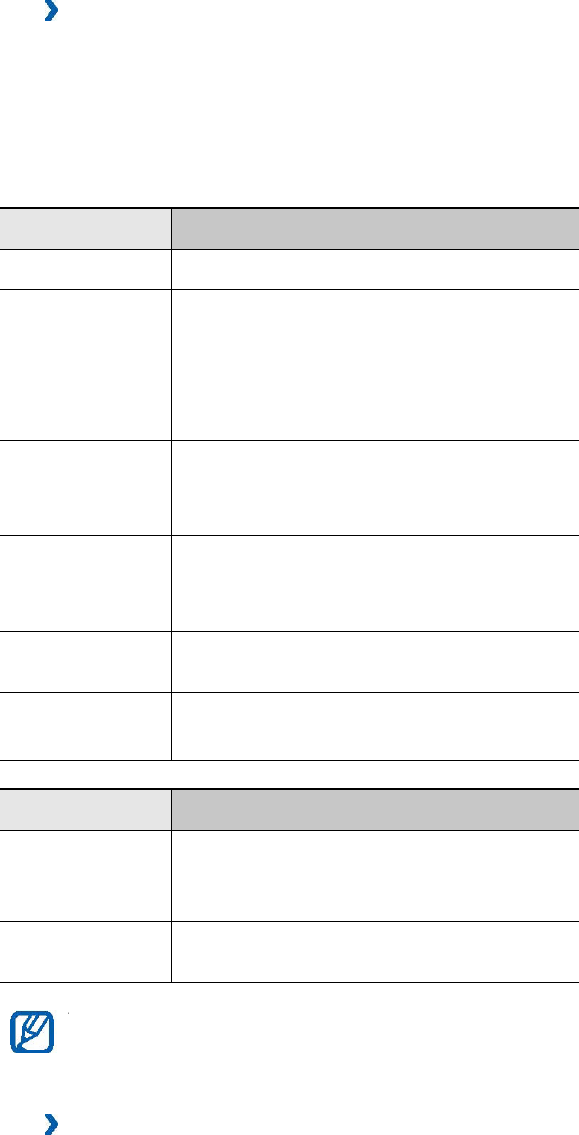
will automatically search for available WLANs. 2 Select the check box
next to a network. 3 Enter a password for the network and select
Done (if necessary).
› Customise the connection profile
1 In Menu mode, select Settings →Connectivity →Wi-Fi. 2 Select
the discovered WLAN AP. The current connection profile for the
network appears. 3 Customise the connection profile of the selected
WLAN:
Option Function
Name View the name of the profile.
Security
type EAP
method
View the security type of the
WLAN AP. Select an EAP
method. This option is available
depending on the selected
security type.
User name
Enter your user name. This
option is available depending on
the selected security type.
Password
Enter your password. This option
is available depending on the
selected security type.
IP address
View your IP address of the
WLAN AP.
IP address
type
Select the IP address type of the
WLAN AP.
Option Function
Proxy
address and
port
Enter the address and port
number of the proxy server.
AP MAC
View the MAC address of the
WLAN AP.
To delete all details of the connection profile, select Forget.
› Connect to a WLAN using a Wi-Fi Protected Setup
(WPS)
1 In Menu mode, select Settings →Connectivity →Wi-Fi. 2
Select WPS PBC or WPS PIN depending on the AP device type. 3
Press a WPS button on the AP device within 2 minutes. Or, enter
a PIN on the AP device and select Start within 2 minutes.
Mobile AP
Learn about the Mobile AP feature, which sets your device as an wireless AP
(Access Point) to connect to the internet on other network devices.
1 In Menu mode, select Settings → Connectivity → Mobile AP.
2 Select Mobile AP on the top to activate the Mobile AP feature.
3 Select OK to confirm.
IC notice
This Class B digital apparatus complies with Canadian ICES-003.
Cet appareil numérique de la classe B est conforme à la norme NMB-003 du
Canada
This device complies with Industry Canada licence-exempt RSS standard(s).
Operation is subject to the following two conditions: (1) this device may not cause
interference, and (2) this device must accept any interference, including interference
that may cause undesired operation of the device.
Le présent appareil est conforme aux CNR d'Industrie Canada applicables aux
appareils radio exempts de licence. L'exploitation est autorisée aux deux conditions
suivantes : (1) l'appareil ne doit pas produire de brouillage, et (2) l'utilisateur de
l'appareil doit accepter tout brouillage radioélectrique subi, même si le brouillage est
susceptible d'en compromettre le fonctionnement.
PC Connections
You can connect your device to a PC using an optional PC data cable using various USB connection
modes. When you connect the device to a PC, you can synchronize files with Windows Media Player,
transfer data to and from your device directly, or launch Samsung PC Studio when a USB connection
is detected.
Configuring Your Phone USB Settings
Configuring Your Phone USB Settings
This menu selects the method of communication for the USB port.
Note: The Bluetooth feature must first be disabled before initiating a USB connection with the phone.
Prior to connecting the USB cable to the phone, install the latest version of the PC Studio application.
This application installs the necessary USB drivers onto your machine. For a free download of PC
Studio, go to www.samsung.com/us/support.
1.Touch ➔ Settings ➔ Connectivity ➔ Select USB mode.
2. Select one of the following USB modes:
•Ask on connection: causes the phone to present a “Select USB Mode” pop-up when
you connect to the PC. You can then choose from either: Samsung PC Studio, Media
player, or Mass storage.
•Samsung PC Studio: sets PC Studio to launch as the default application when a USB
connection is detected.
•Media player: sets the Media Player to launch as the default application when a USB
connection is detected.
•Mass storage: allows you to utilize the onboard storage capacity of the phone’s microSD
card to store and upload files. This option allows your computer to detect the phone’s
microSD card as a removable storage drive.
3.Touch Save.
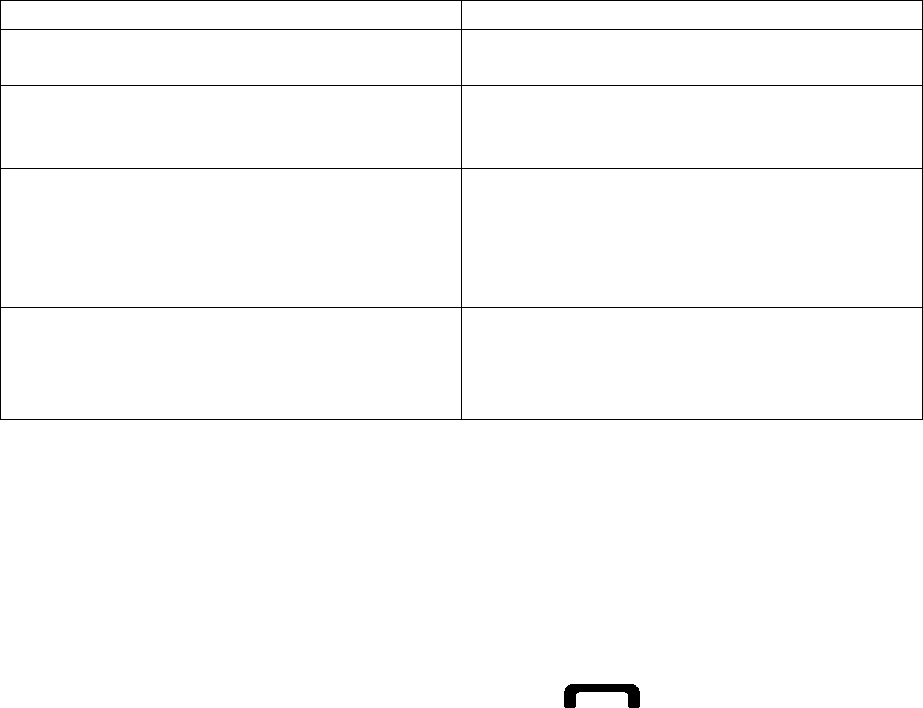
troubleshooting
If you are having trouble with your mobile phone, try these troubleshooting
procedures before contacting a service professional.
While using your phone, the following messages may appear:
Message
Try this to solve the problem:
Please insert SIM card
Ensure that the SIM card is installed
correctly.
Phone lock
When the phone lock feature is enabled,
you must enter the password you set for
the phone.
Enter PIN
When using the phone for the first time
or when the PIN requirement is enabled,
you must enter the PIN supplied with the
SIM card. You can disable this feature
by using the PIN lock menu.
Enter PUK
Your SIM card is blocked, usually as a
result of entering your PIN incorrectly
several times. You must enter the PUK
supplied by your service provider.
Your phone displays “Network unavailable” or “Network error.”
When you are in areas with weak signals or poor reception, you may lose
reception. Move to another area and try again.
You cannot access some options without a subscription. Contact your service
provider for more details.
You enter a number, but the call is not dialled.
Ensure that you have pressed the Dial key: [ ].
Ensure that you have accessed the right cellular network.
Ensure that you have not set call barring for the phone number.
Another caller cannot reach you.
Ensure that your phone is turned on.
Ensure that you have accessed the right cellular network.
Ensure that you have not set call barring for the phone number.
Another caller cannot hear you speaking.
Ensure that you are not covering the built-in microphone.
Ensure that the microphone is close to your mouth.
If using a headset, ensure that it is properly connected.

The phone beeps and the battery icon flashes.
Your battery is low. Recharge or replace the battery to continue using the phone.
The audio quality of the call is poor.
When you are in areas with weak signals or poor reception, you may lose
reception or experience poor audio quality. Move to another area and try
again.
When you are in areas with weak signals or poor reception, you may lose
reception. Move to another area and try again.
You select a contact to call, but the call is not dialled.
Ensure that the correct number is stored in the contact list.
Re-enter and save the number, if necessary.
The battery does not charge properly or sometimes the phone turns itself off.
The battery terminals may be dirty. Wipe both gold-coloured contacts with a
clean, soft cloth and try charging the battery again.
If the battery will no longer charge completely, dispose of the old battery
properly and replace it with a new battery.
Your phone is hot to the touch.
When you use several applications at once, your phone requires more power and
may heat up.
This is normal and should not affect your phone’s lifespan or performance.
Some of the contents in this manual may differ from your phone depending on
the software of the phone or your service provider.
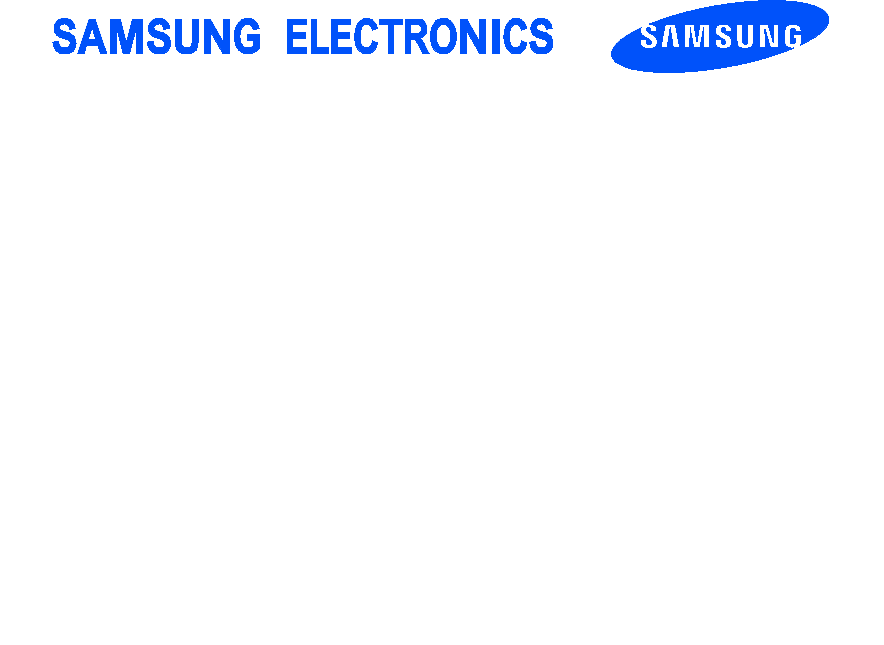
World Wide Web
http://www.samsungmobile.com
Printed in Korea
Code No.:GH68-XXXXXA
English (EU). 10/2011. Draft.05